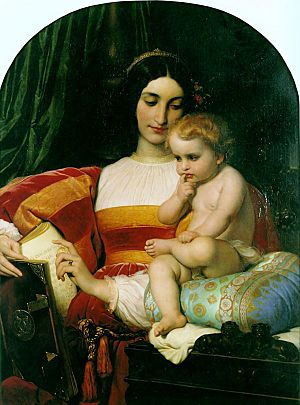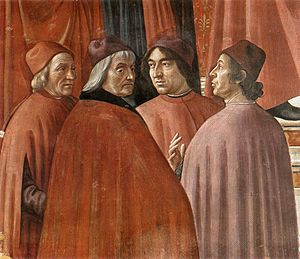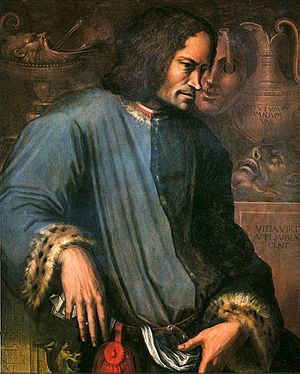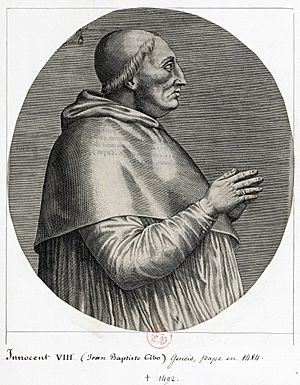Giovanni Pico della Mirandola facts for kids
Quick facts for kids
Pico della Mirandola
|
|
|---|---|

Portrait from the Uffizi Gallery, in Florence
|
|
| Born | 24 February 1463 Mirandola, Duchy of Mirandola
|
| Died | 17 November 1494 (aged 31) Florence, Republic of Florence
|
| Education | University of Bologna, University of Ferrara, University of Padua, University of Paris |
| Era | Renaissance philosophy |
| Region | Western philosophy |
| School | Renaissance philosophy Christian humanism Neoplatonism |
|
Main interests
|
Politics, history, religion, esotericism |
|
Influences
|
|
|
Influenced
|
|
Giovanni Pico della Mirandola (born February 24, 1463 – died November 17, 1494) was an important Italian nobleman and philosopher during the Italian Renaissance. He is well-known for an event in 1486. At only 23 years old, he offered to debate 900 ideas about religion, philosophy, science, and even magic.
For this debate, he wrote a famous speech called Oration on the Dignity of Man. This speech is often called the "Manifesto of the Renaissance." It was a key text for Renaissance humanism, which focused on human potential and achievements. Pico also started the idea of Christian Kabbalah, which combined Christian and Jewish mystical ideas. His collection of 900 ideas, called the 900 Theses, was the first printed book ever banned by the Church.
Contents
Biography
Pico's Family Background
Giovanni Pico della Mirandola was born in Mirandola, a small independent area near Modena, Italy. He was the youngest son of Gianfrancesco I Pico, who was the Lord of Mirandola. His family had lived in the Castle of Mirandola for a long time.
The Pico della Mirandola family was connected to other powerful families in Italy. Giovanni had two older brothers. His brother Galeotto I continued the family line. His other brother, Antonio, became a general in the army.
Giovanni's mother's family was also very important in the arts and learning of the Italian Renaissance. His cousin, Matteo Maria Boiardo, was a famous poet.
Pico's Early Education

Giovanni was a very smart child with an amazing memory. He learned Latin and possibly Greek at a young age. His mother wanted him to join the Catholic Church. So, at age 10, he was named a special church official. In 1477, he went to Bologna to study canon law, which is the law of the Church.
Three years later, his mother died suddenly. Pico then decided to stop studying canon law. He began to study philosophy at the University of Ferrara. During a short visit to Florence, he met important people like the poet Angelo Poliziano and the friar Girolamo Savonarola. He remained close friends with them for the rest of his life.
From 1480 to 1482, Pico continued his studies at the University of Padua. This university was a major center for Aristotelianism, a way of thinking based on the ancient Greek philosopher Aristotle. Pico already knew Latin and Greek well. In Padua, he also learned Hebrew and Arabic from a Jewish scholar named Elia del Medigo. He even read ancient Aramaic writings with him.
Pico spent the next four years traveling to different centers of learning in Italy. In 1485, he went to the University of Paris. This was the most important place in Europe for Scholasticism, a type of philosophy and theology. It was likely in Paris that Pico started writing his 900 Theses. He also got the idea to publicly debate these ideas.
The 900 Theses and Papal Opposition
While preparing for his debate, Pico moved to Florence in November 1484. There, he met Lorenzo de' Medici, a powerful ruler and patron of the arts. He also met Marsilio Ficino, a famous philosopher. Pico impressed both men. Lorenzo de' Medici became Pico's supporter and protector until Lorenzo's death in 1492.
Soon after, Pico traveled to Rome. He planned to publish his 900 Theses there. He also wanted to arrange a meeting for scholars from all over Europe to debate his ideas. On his way, he stopped in Arezzo. There, he got into some trouble related to a woman. He was caught and put in prison. Lorenzo de' Medici had to step in to get him released.
Pico spent several months recovering in Perugia. It was there that he discovered ancient "Chaldean" books. He also became fascinated by the mystical Hebrew Kabbalah. The Kabbalah and other ancient writings were believed at the time to be as old as the Old Testament. Pico's teacher in Kabbalah was Rabbi Johannan Alemanno. This meeting led to new ideas that mixed Jewish and Christian thought.
Pico's most original ideas in his 900 theses were about the Kabbalah. He became the founder of Christian Kabbalah. This tradition became a key part of early modern Western esotericism, which explores hidden knowledge. Pico believed in combining different philosophies, a practice called syncretism. He thought that many different ideas could actually agree with each other.
Pico based his ideas mainly on Plato, like his teacher Marsilio Ficino. But he also respected Aristotle. Pico believed that Plato and Aristotle were trying to express the same ideas using different words. Because of this, his friends called him "Prince of Harmony." Pico also thought that educated people should study Hebrew, Talmudic writings, and Hermetic texts. He believed these texts showed the same idea of God found in the Old Testament, just in different ways.
Pico finished his famous speech, Oration on the Dignity of Man, to go with his 900 Theses. He traveled to Rome to continue his plan for the debate. In December 1486, he published his ideas as "Conclusiones philosophicae, cabalasticae et theologicae" (Philosophical, Cabalistic, and Theological Conclusions). He even offered to pay for the travel of any scholars who came to Rome to debate him. He wanted the debate to start on January 6, a date that was important for its symbolic meaning.
However, in February 1487, Pope Innocent VIII stopped the planned debate. He set up a group to review Pico's 900 Theses. Even though Pico tried to explain his ideas, thirteen of his theses were condemned. Pico agreed to take them back in writing, but he still believed they were true. Eventually, all 900 theses were condemned.
Pico then wrote a defense of his ideas, called Apologia. He dedicated it to his protector, Lorenzo de' Medici. When the Pope found out about this defense, he started an investigation. Pico was forced to give up his Apologia and his condemned theses. The Pope said the 900 Theses were "heretical," "scandalous," and "offensive." He also said they supported magic, which was against the Catholic faith.
This was the first time a printed book was banned by the Church. Almost all copies were burned. Pico fled to France in 1488. He was arrested there but was released thanks to the help of Lorenzo de' Medici and King Charles VIII of France. The Pope allowed Pico to move to Florence and live under Lorenzo's protection. But Pico was not fully cleared by the Church until 1493.
This experience greatly affected Pico. He became closer to Savonarola, who was a very good friend. Pico even convinced Lorenzo to invite Savonarola to Florence. Pico never gave up his belief in combining different ideas. He settled in a villa near Fiesole and continued to write. He published Heptaplus (1489) and De Ente et Uno (Of Being and Unity, 1491). He also wrote his important work, Disputationes adversus astrologiam divinicatrium (Treatise Against Predictive Astrology). This book was published after his death. In it, Pico strongly criticized the practice of astrology.
After Lorenzo de' Medici died in 1492, Pico moved to Ferrara, but he still visited Florence. In Florence, political problems led to Savonarola gaining more power. Savonarola was against the Renaissance style and even caused books and paintings to be destroyed. Despite this, Pico became a follower of Savonarola. He decided he wanted to become a monk. He stopped being interested in Egyptian and Chaldean texts, destroyed his own poetry, and gave away his wealth.
Pico's Death

In 1494, at the age of 31, Pico died under mysterious circumstances. His friend Poliziano also died around the same time.
Some people rumored that Pico's own secretary had poisoned him. This was because Pico had become very close to Savonarola. Pico was buried in the Church of San Marco in Florence. Savonarola gave the speech at his funeral.
In 2007, the bodies of Poliziano and Pico were examined. Tests showed that both likely died from arsenic poisoning. This might have been ordered by Piero de' Medici, who took over after Lorenzo.
Pico's Important Writings
Pico wrote many important works that shared his unique ideas.
Oration on the Dignity of Man
In his Oratio de hominis dignitate (Oration on the Dignity of Man, 1486), Pico explained why it was important for humans to seek knowledge. He believed that humans had a special place in the world.
The Oration also introduced Pico's 900 theses. He thought these ideas could lead to all knowledge. The 900 Theses showed Pico's syncretism. He combined ideas from Platonism, Neoplatonism, Aristotelianism, Hermeticism, and Kabbalah. They also included 72 ideas about what Pico believed was a complete system of physics.
Pico's De animae immortalitate (On the Immortality of the Soul, 1541) and other works discussed the idea that humans have an immortal soul. This soul, he believed, gave humans freedom. Pico also believed that even serious sins would not lead to eternal punishment, but only temporary punishment. This idea was among those the Pope called heretical.
In the Oration, Pico argued that humans have a special calling. This calling involves three steps: becoming a better person, seeking knowledge, and finally, becoming one with a higher reality. He believed this path was universal and could be found in every tradition.
Treatise Against Predictive Astrology
A part of his Disputationes adversus astrologiam divinatricem (Treatise Against Predictive Astrology) was published after his death. In this book, Pico argued against the practice of astrology. His arguments have been important for centuries.
Pico's main reason for opposing astrology was that it conflicted with the Christian idea of free will. Astrology suggests that our lives are determined by the stars. But Pico believed humans had the freedom to choose their own path.
Other Key Works
Early in his career, Pico wrote a Commento. In this work, he planned to write a book called Poetic Theology. He believed that ancient thinkers hid divine secrets in poetic language. He wanted to explain how this was done by Greek and Latin poets.
Pico's Heptaplus is a mystical explanation of creation based on the Bible. It explains his idea that different religions and traditions are all describing the same God.
On Being and the One (De ente et uno) explains passages from the Bible, Plato, and Aristotle. It tries to show how Plato and Aristotle's ideas about "being" and "the one" can be reconciled.
Pico also wrote letters that are important for understanding his time. Many editions of his complete works were published in the 1500s, showing his influence.
Another famous text by Pico is De omnibus rebus et de quibusdam aliis ("Of all things that exist and a little more"). This title playfully makes fun of another famous book, Lucretius' De rerum natura (On the Nature of Things).
See also
 In Spanish: Giovanni Pico della Mirandola para niños
In Spanish: Giovanni Pico della Mirandola para niños
- Christian Kabbalah
- Contemporary Italian Renaissance philosophers: Marsilio Ficino, Lodovico Lazzarelli, Giovanni Mercurio da Correggio
- Hermetica (philosophical writings attributed to Hermes Trismegistus)
- Hermeticism
- Perennial philosophy
- Platonic Academy (Florence)
- Renaissance humanism
- Renaissance magic




